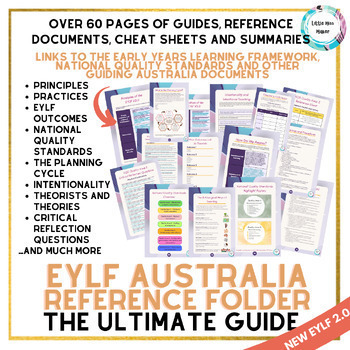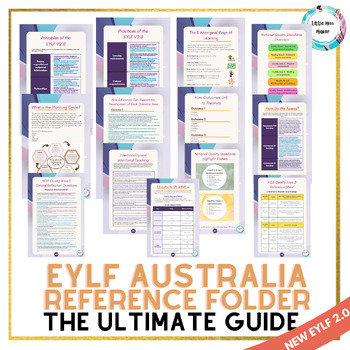Australian Early Years Reference Folder Guide - EYLF NQS Theorist Cheat Sheet
Description
Are you a new educator? Do you run an Australian Education and Care Service with new staff? Are you looking for ways to support and develop your existing staff or those in new leadership positions? Do you have an A&R coming up and want to ensure all staff are expertly prepared? Have you recently gone through an A&R and are looking for ways to improve your practices and achieve an exceeding or excellent rating? Are you looking for more quality resources to utilise in your service that are Australian-made by a qualified expert in the field?
This Ultimate Australian Early Years Reference Guide Folder is a 70 page document that includes all the information you need to support your service to achieve and maintain a high standard of quality care.
What's Included?
A title Page
Contents Pages
Page 1 - Acknowledgement of Country
Page 2 - The Early Years Learning Framework (EYLF) V2.0 - a breakdown of ' Belonging, Being and Becoming'
Page 3 - Overview of the EYLF V2.0 - a 'cheat sheet' reference sheet of the Principles, Practices and Outcomes of the NEW EYLF 2.0 (2022/23 Update)
Page 4-6 - Principles of the EYLF V2.0 - key points of each principle of the EYLF V2.0 highlighted in an easy-to-read table
Page 7-9 - Practices of the EYLF V2.0- key points of each practice of the EYLF V2.0 highlighted in an easy-to-read table
Page 10-11 - Intentionality and Intentional Teaching - an explanation of what intentionality is and a detailed list of examples of ways educators can act with intentionality within an ECEC service.
Page 12 - The Outcomes of the EYLF V2.0 - a 'cheat sheet' reference page of the 5 learning outcomes and their sub-outcomes
Page 13-17 - How Educators Can Support the Development of Each Outcome Area - A detailed list of ways educators can support children in developing within each outcome area
Page 18 - How Outcomes Link to Theorists - a 'cheat sheet' reference page with the names of theorists who have theories or ideas that link best to each outcome area.
Page 19 - Theorists in Detail - Jean Piaget
Page 20 - Theorists in Detail - Erik Erikson
Page 21 - Theorists in Detail - Jean-Jacques Rousseau
Page 22 - Theorists in Detail - Friedrich Froebel
Page 23 - Theorists in Detail - Kenneth Rubin
Page 24 - Theorists in Detail - Uri Bronfenbrenner
Page 25 - Theorists in Detail - Maria Montessori
Page 26 - Theorists in Detail - John Dewey
Page 27 - Theorists in Detail - B. F. Skinner
Page 28 - Theorists in Detail - Mildred Parten
Page 29 - Theorists in Detail - Rudolph Steiner
Page 30 - Theorists in Detail - Lev Vygotsky
Page 31 - Theorists in Detail - Howard Gardner
Page 32 - Theorists in Detail - Loris Malaguzzi
Each of these is a detailed one-page summary of each theorist's key theories and ideas and an explanation of them.
Page 33 - National Quality Standards Overview - a 'cheat sheet' reference page with the 7 Quality Areas of the NQS.
Page 34-37 - National Quality Standards Highlight Posters - Small reference-size versions of my NQS Standards posters which highlight 4-7 key points from each Quality Area
Page 38-39 - NQS Quality Area 1 Reference Sheet
Page 40 - NQS Quality Area 2 Reference Sheet
Page 41 - NQS Quality Area 3 Reference Sheet
Page 42 - NQS Quality Area 4 Reference Sheet
Page 43 - NQS Quality Area 5 Reference Sheet
Page 44 - NQS Quality Area 6 Reference Sheet
Page 45 - NQS Quality Area 7 Reference Sheet
Each of these are 'cheat sheet' reference documents of the standards and elements of each quality area.
Page 46 - NQS Quality Area 1 Critical Reflection Questions
Page 47 - NQS Quality Area 2 Critical Reflection Questions
Page 48 - NQS Quality Area 3 Critical Reflection Questions
Page 49 - NQS Quality Area 4 Critical Reflection Questions
Page 50 - NQS Quality Area 5 Critical Reflection Questions
Page 51 - NQS Quality Area 6 Critical Reflection Questions
Page 52 - NQS Quality Area 7 Critical Reflection Questions
Each of these are a detailed list of critical reflection questions that your professional learning team can discuss in the process of continuous quality improvement for each Quality Area. Particularly helpful when updating documents such as the QIP, philosophy or service procedures, during regular professional reflection meetings, or before an A&R.
Page 53 - The 8 Aboriginal Ways of Learning - a 'cheat sheet' reference page with the 8 Aboriginal Ways of Learning.
Page 54 - What is the Planning Cycle? - an explanation of the planning cycle in the Early Years with a supporting visual for quick reference.
Page 55 - How do We Observe? - An outline of why we observe, what information we are looking for when observing, and some common types/tools for observation that we might use
Page 56 - What is a Learning Story? - a description and example of a Learning Story to support educators in creating quality observations to share with families and community.
Page 57 - How Do We Assess? - A detailed description of the 3 main types of assessment used in Australia - assessment FOR, AS and OF learning.
Page 58 - How do We Plan? - An explanation of planning and some common tools/types of planning documents that we can use to record and communicate about planning to staff, children and families.
Page 59 - What is a Quality Improvement Plan (QIP)? - An explanation of the QIP and a list of our requirements under ACECQA
Page 60 - Educator to Child Ratios - a 'cheat sheet' reference page with the ratios of each age group for each state and territory in Australia.
Page 61 - What is an Educational Leader? - A detailed outline of the role of an educational leader and how to select a suitable person for the role.
Page 62 - How Does an Educational Leader Support? - A detailed outline of how an educational leader supports and how they can be supported by their director and management.
Page 63 - The United Nations Convention on the Rights of the Child - An outline of the UN Convention of the Rights of the Child and a link to the full document.
Page 64 - The Disability Discrimination Act - An outline of the Disability Discrimination Act, its importance, and our regulatory requirements.
Page 65 - National Law and National Regulations - A brief outline of the National Law and National Regulations
Page 66 - Policies and Procedures - An explanation of policies and procedures and our legislative requirements, including a list of required procedures.
A back title page
------------------------------------------------
70 Pages TOTAL
You Might Also Like:
EYLF v2.0 Early Years Learning Framework Educator BUNDLE-EDITABLE Obs, A&R
EYLF Learning Stories FULL YEAR BUNDLE -EDITABLE Observation Templates Australia
Take Home Toy Travelling Teddy Bear EDITABLE COMPLETE BUNDLE -EYLF, Preschool
First Day of Preschool Back to School BUNDLE - Schedule, Printables, Activities
Guided Mindfulness Meditation Video 1 - Mental Health, Wellbeing, Calming
Keep in Touch with me!
Little Miss Maker Mail (Email)
>>>>>>>>>>>>>>>>>>>>>>>>>>>>>>>>>>>>>>>>>>>>>>>>>>>>>>>>>>>>>>>>>>>>>>>
Want more resources for FREE? You can get my Brain Breaks For Any Age - Printables for Popsicle Sticks and Guide with Visuals (teacherspayteachers.com) as a FREEBIE when signing up to my mailing list! (Normally priced at $4.50!)
Just click here---------> https://mailchi.mp/13789a07a051/little-miss-maker-mail
>>>>>>>>>>>>>>>>>>>>>>>>>>>>>>>>>>>>>>>>>>>>>>>>>>>>>>>>>>>>>>>>>>>>>>>>
If you're a regular user of Teachers Pay Teachers or you enjoy my resources, consider leaving a review. When you leave a review, you'll earn 1 credit for every $1 you spent on that resource. Each credit has a value of 5 cents, so every 20 credits earned equals $1 you can apply to future TPT purchases.
After using a resource, you can leave a rating and review by following these steps:
- Go to your "My Purchases" page.
- Click the "Leave a review" button (Note: you won't be able to leave a review until you've used the resource)
- Answer each question and leave a review sharing more about your experience with the resource. Then, click "Done."



